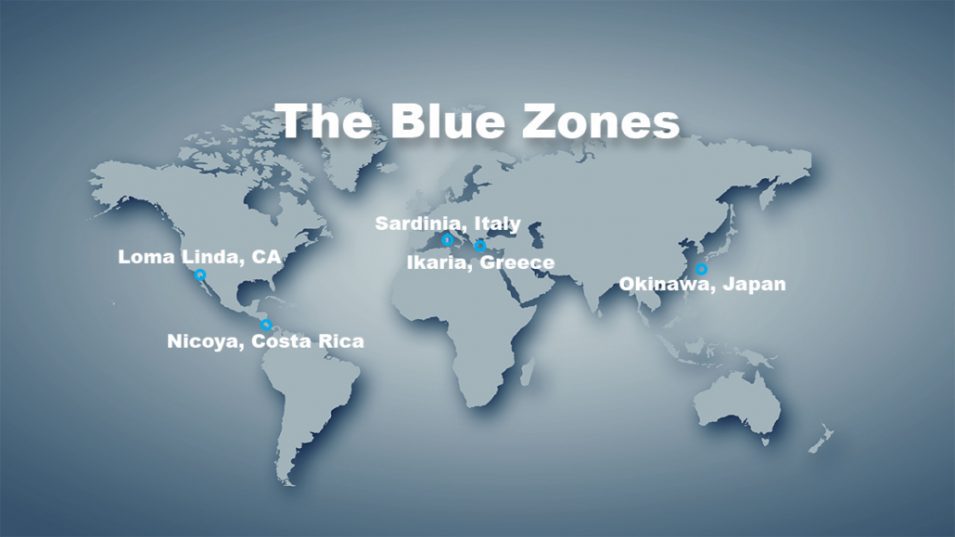blue zones
The Blue Zone Myth.


Image Pixabay
Blue Zone regions are areas where people are claimed to live to a very old age. They have been studied and written about for years. What they eat, how active they are, whether they belong to a religious group and how well they connect within their community have all been documented. A lot of the data is based on government documents.
According to recent analysis, these pockets of extreme longevity seem to occur in areas with greater poverty, higher illiteracy, higher crime rates, and worse population health than the norm. They are found in Sardinia, Okinawa, the Greek island of Ikaria, Loma Linda in California, and Nicoya, a poor province of Costa Rica. The longevity of the “Supercentenarians” is attributed to the consumption of a variety of certain tubers, wholegrains, and fermented foods. A whole “Superfoods and Lifestyle” and publishing industry has grown up around these claims with much capital and employment invested in it.


Image Pixabay
A well researched investigation conducted by Oxford University’s Leverhulme Centre for Demographic Science tells a different story. Working with the Greek Labour Ministry they found that most of the country’s 9,000 centenarians were actually dead. A similar investigation conducted in Japan discovered that 238,000 people listed as aged 100 or more were unaccounted for. Some had died in the Second World War! The centenarians of Okinawa allegedly living on seaweed and the purple sweet potato, a superfood rich in anthocyanins and phenols, were found to have consumed less sweet potatoes than the rest of the country, less fruit and seafood, and more processed food. Japan has kept nutritional data as far back as the 1970s. It shows that Okinawa had the worst obesity problem even then. What all these regions have in common is dependency on pensions/social security. It’s worth keeping your family member on the books!
Based on an article by Dr Saul Newman The Oxford University Leverhulme Centre for Demographic Science
The release of these findings coincides with a extensive British campaign to promote a plant based diet. This is also being pushed by the EU to try to influence climate change. The British model encourages children to eat from the ‘rainbow’ of foods. They’re told to eat 30 plant based foods a week. Four spices equal one plant based food, otherwise it’s fruit and vegetables, plus flour and oatmeal and other plant products and legumes. So, no eggs, meat, fish or chicken. Only plant based oils are acceptable. No butter. Only plant based milks and yoghurts and other non-diary products are allowed. Are plant based milks actually milks?
The UN is also pushing for a shift to a plant based diet, claiming this will reduce the ecological footprint of food production. Interestingly, the UN includes eggs in their list of acceptable foods. Don’t they come from birds?
One of the two major supermarket chains in Australia is also promoting a similar program of eating from the rainbow. Children can collect a chart from the supermarket to record how many plant based foods they eat in a seven day period. They write them in a colour coded column. The chart also features a box where an agreed award is listed if they meet their goal for the week. I’m assuming it’s not a visit to McDonalds.


Image Pixabay
The whole issue of Blue Zones obviously needs more research. Some of the concepts attributed to the very old in these regions make nutritional sense, except the research suggests the younger generation eat differently, anyway. So, back to the Mediterranean Diet, which is a great way to eat with easily sourced foods.
clothes, decorating and fashion
When I read about the impact fashion posts on Instagram have, I do wonder about the age of the viewer to actually care or be influenced. Apparently millions of followers on Instagram and Tiktok do care and follow their idols’ examples of clothing and accessories closely, often checking several times a day.
When I think of fashion icons I think of Coco Chanel, who believed in restraint and advised women to take off one thing as they went out the door and the amazing Iris Apfel, who recently died, aged 102. Ms Apfel had no time for beige or the less is more dictate, she preferred a kaleidoscopic approach to dressing. This meant second hand pieces with couture, layers of clanking priceless jewels on her wrists and around her neck mixed with thrift shops pieces and always huge, colourful owl-like glasses. Joyful and expressive. So, I think we should suit ourselves, buy what we really like and keep it for as long as possible. Disposable clothing equals landfill.


Image Pixabay
International taste in interiors has taken an about turn in the last 18 months judging by the magazines I read. Gone is white everything. Now the focus is on patterns and colours, open bookshelves displaying your treasures and lots of texture. Adding inherited pieces or second hand finds is essential and there’s colour everywhere. This looks nice and cosy in a European climate, but those intense colours and metres of curtains and ruffles might bring you out in hives on a hot summer’s day here. We are still having 30ºC (86ºF) days in Perth. Just remember, you can’t actually get personal taste wrong!

Your content is consistently great.
Thankyou!